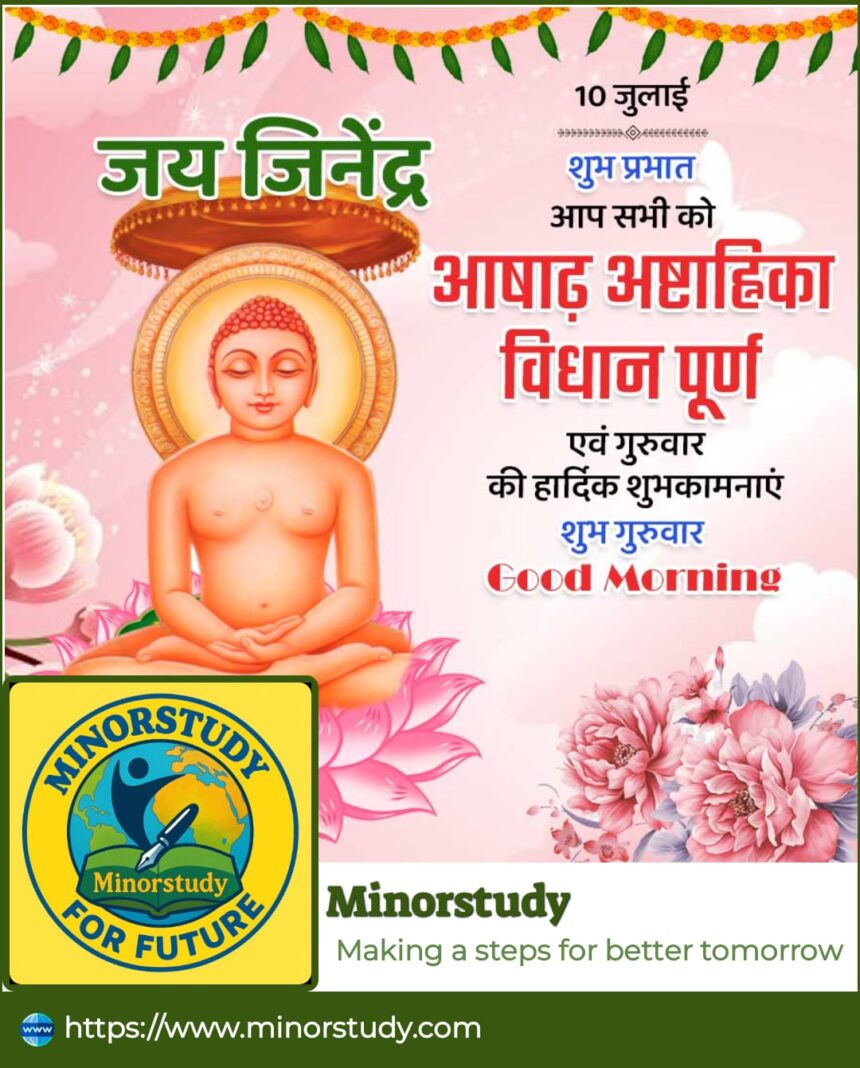🌺 Ashadh Ashtahika Vidhan – A Sacred Journey of Eight Transformational Days
“Dharma is subtle, eternal, and luminous. Let us walk the eightfold path to purify ourselves.”
- 📜 History of Ashadh Ashtahika Vidhan
- 📅 Timeline and Observance Period
- 🔥 7 Sacred Truths That Make Ashadh Ashtahika Vidhan Spiritually Powerful
- 1. It Awakens Self-Awareness
- 2. Fosters Non-Violence (Ahimsa) and Compassion
- 3. Purifies Speech and Mind
- 4. Strengthens Family and Community Bond
- 5. A True Detox from Materialism
- 6. Honors Jain Tirthankaras with Reverence
- 7. Lays the Foundation for Paryushan and Chaturmas
- 📚 Interesting Facts About Ashadh Ashtahika Vidhan
- 🧘 Human-Friendly Observance: How Common People Participate
- 🎊 Wishing Messages for Ashadh Ashtahika Vidhan
- ❓FAQs – Common Questions About Ashadh Ashtahika Vidhan
- 💡 Key Points Summary
- 🧭 Importance in Daily Life and Society
- 🌈 Conclusion: Transforming Karma, One Day at a Time
Ashadh Ashtahika Vidhan is one of the most profound and spiritually intense observances in Jainism, practiced especially in the Shwetambar Jain tradition. Taking place during the bright half of the month of Ashadh (June–July), this eight-day sacred observance is filled with rituals, introspection, fasting, devotion, and scriptural study.
This period is not just about rituals—it’s about purification of thoughts, speech, and deeds, fostering self-discipline and connecting deeply with the core of one’s soul. Let’s take a human-friendly deep dive into its history, significance, facts, timeline, FAQs, daily impact, and why it still holds great relevance in today’s chaotic life—in more than 1200 words.
📜 History of Ashadh Ashtahika Vidhan
Ashadh Ashtahika Vidhan traces its origin to the early Jain scriptures, especially in the Kalpa Sutra and Nishitha Sutra, which outline monsoon-based observances. It was instituted as a special eight-day festival where monks, nuns, and laypeople could cleanse their karmas through prescribed rituals and spiritual discipline.
Historically:
Jain monks remain stationary during Chaturmas (the four monsoon months) to prevent harm to living beings.
Within this, Ashtahika Vidhan became a key observance to enhance self-restraint, engage in Puja, Penance (Tapas), Pratikraman, and reflect on key Jain Tirthankaras and philosophies.
The Ashtahika Vidhan gained prominence through the efforts of Acharyas like Bhadrabahu and later, Jain scholars and Muni Maharaj Ji who formalized the vidhan (procedure) for laypeople.
📅 Timeline and Observance Period
| 📅 Day | Observance |
|---|---|
| Day 1 (Prathama) | Mangalik Puja, worship of Jina idols begins |
| Day 2–3 | Padmavati or Chakreshwari Devi worship and inner purification |
| Day 4 | Recitation of Jain Agamas or scriptures |
| Day 5–6 | Meditation and Tapasya, Pratikraman for repentance |
| Day 7 | Worship of 24 Tirthankaras collectively |
| Day 8 (Ashtami) | Completion of Vidhan, Grand Snatra Puja, and Samvatsari-like rituals |
🔥 7 Sacred Truths That Make Ashadh Ashtahika Vidhan Spiritually Powerful
1. It Awakens Self-Awareness
Through rituals like Pratikraman and Samayik, individuals confront their daily transgressions and seek internal cleansing. This leads to a heightened awareness of thoughts and behaviors.
2. Fosters Non-Violence (Ahimsa) and Compassion
Following strict vows during these eight days, such as avoiding root vegetables or extra mobility, reflects an attempt to minimize harm to even microscopic life forms.
3. Purifies Speech and Mind
Chanting of Jain mantras like “Navkar Mantra” and engaging in scriptural reflection (Swadhyaya) purifies not just the body but also speech, thoughts, and emotions.
4. Strengthens Family and Community Bond
Families participate together, often waking up early, attending temple vidhans, and serving or organizing Samosharan Mandals, creating a sense of unity.
5. A True Detox from Materialism
With fasting, silence, reduced sensory pleasures, and devotion, the Ashtahika Vidhan acts as a spiritual detoxification program, helping to break worldly attachments.
6. Honors Jain Tirthankaras with Reverence
The 24 Tirthankaras and Jina idols are honored with Panchamrit Abhishek, Shantidhara, Snatra Puja, and Aarti, connecting devotees to the soul’s divine goal — moksha (liberation).
7. Lays the Foundation for Paryushan and Chaturmas
Ashadh Ashtahika is like the spiritual warm-up to the grand Paryushan Mahaparva. It sets the tone for repentance, forgiveness, and inward journeys.
📚 Interesting Facts About Ashadh Ashtahika Vidhan
The word “Ashtahika” comes from Sanskrit, meaning “eightfold observance”.
It is one of the few vidhans that lays equal emphasis on rituals and internal purification.
Shwetambar sects especially observe it rigorously in community temples.
Tapasvis (ascetics or even laypersons) often take up partial or complete fasts during these eight days.
On the 8th day (Ashtami), devotees perform Gyan Puja – a symbolic worship of wisdom.
🧘 Human-Friendly Observance: How Common People Participate
Despite fast-paced modern life, many families still find joy and spiritual peace during Ashtahika Vidhan through:
🪔 Daily temple visits and morning snatra puja
📖 Reading Jain stories (Charitra kathas) with kids
🍵 Fasting or abstaining from evening meals (Chauvihar)
🧘♀️ Practicing silence for an hour (Maun Tap)
🙏 Seeking forgiveness from relatives, neighbors, and co-workers
🎶 Organizing bhajan sandhyas or Jain song evenings
💸 Donating to temple rituals or organizing mass pujas
🎊 Wishing Messages for Ashadh Ashtahika Vidhan
🪷 “May the eight days of Ashtahika Vidhan purify your soul, thoughts, and karmas. Jai Jinendra!”
🪷 “Wishing you a sacred and peaceful Ashadh Ashtahika — may your soul rise above worldly illusions.”
🪷 “On this auspicious Vidhan, may Tirthankaras bless you with inner light, love, and liberation.”
🪷 “Happy Ashtahika! Let’s walk the eightfold path with truth, compassion, and devotion.”
❓FAQs – Common Questions About Ashadh Ashtahika Vidhan
Q1. What is the meaning of Ashtahika Vidhan?
“Ashtahika” means eight-day observance, and Vidhan means ritual procedure. It’s a spiritually disciplined celebration of self-purification.
Q2. When is Ashadh Ashtahika Vidhan celebrated?
It begins on the Shukla Paksha Prathama (1st day) and ends on the Ashtami (8th day) in the Ashadh month (June–July).
Q3. Who performs Ashadh Ashtahika Vidhan?
It is primarily observed by Shwetambar Jain devotees, including monks, nuns, and householders, across India and abroad.
Q4. Is fasting mandatory during this Vidhan?
No, but many devotees observe Ekasana, Ayambil, or Upvas. Even small acts like avoiding mobile phones or gossip are considered spiritual fasting.
Q5. Is it different from Paryushan?
Yes. Paryushan is a larger 8-day Jain festival, while Ashtahika Vidhan is a more focused religious discipline during Ashadh month.
💡 Key Points Summary
Celebrated in Ashadh month (June–July) for eight days
Rooted in Jain philosophy of karma cleansing
Involves pujas, fasting, pratikraman, gyan bhakti, and daily rituals
Encourages ethical, truthful, and compassionate living
A time for inner reflection and forgiveness
Sets tone for Paryushan Mahaparv
🧭 Importance in Daily Life and Society
In a world that often promotes chaos and consumption, Ashadh Ashtahika Vidhan offers a pause — an opportunity to:
Reconnect with your inner self
Reset your mental and emotional health
Refocus on non-violence, forgiveness, and humility
Rebuild family and spiritual values
It reminds society that true power lies in restraint, true joy lies in simplicity, and true progress lies in ethical living.
🌈 Conclusion: Transforming Karma, One Day at a Time
Ashtahika Vidhan is not just a festival — it’s a mirror. A mirror where we examine our intentions, clean our karmic stains, and pledge to become better versions of ourselves.
🪷 In just eight days, you rediscover the timeless Jain path — the path of right knowledge, right conduct, and right faith.
So this Ashadh, join the sacred journey of the soul.
🛕 Bow to the Tirthankaras, walk with humility, and let your inner light guide others.
Jai Jinendra!








